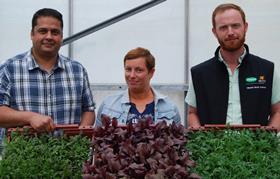
Based in the Salinas Valley, a major production area in California dubbed the ‘salad bowl of the world’, innovations from the Vilmorin-Mikado breeding programme are finding their way to the UK market via distributor Hazera Seeds.
“In the US, the focus in the salads market remains very much on ready-prepared, snacking and nutrient-rich combinations, and these trends are showing no signs of diminishing,” says Dowling. “Consumers are very broadly split between those focused on taste, colour and shelf life and those concerned most with nutritional value. ‘Nourish bowls’ − comprising well-balanced, healthy meals with a good portion of nutrient-dense salads, vegetables and/or fruits, combined with carbohydrates and protein plus a dressing − are taking off in North America.”
Breeding programme
In charge of non-lettuce babyleaf varieties, Dowling has breeding responsibility for crops such as chard, rocket, Asian leaves, kale, mustard, beets, mizuna and land cress. He says there is a strong focus on disease resistance. “Not only for downy mildew, but for other pathogens such as fusarium,” he explains. “At Vilmorin-Mikado we are also selecting for consumer traits including improved shelf life and nutritional value. And, to satisfy retailers and processors we’re looking closely at flavour, colour and year-round availability. They ideally want something novel, such as better nutritional value or a unique-shaped leaf, to make their products stand out in this highly competitive sector. We have a very healthy pipeline of new varieties offering grower, processor, retailer and consumer benefits.”
Already popular in the States is the high-iron babyleaf kale KX-1. “With a true shiny red leaf throughout, it has exceptional nutrient content,” explains Dowling. “Two years of tests show KX-1 has similar, or higher, iron levels than spinach. In addition, compared to raw spinach, KX-1 has significantly lower oxalic acid levels, so more iron can be absorbed by the body.
“Amara, an Ethiopian kale, is also a great product gaining traction with American growers because of yield, disease resistance and flexibility. It is suitable for growing year round in all areas,” says Dowling. “Red-veined rockets are also proving very popular due to their visually distinct leaves, giving real ‘bag appeal’. Vilmorin-Mikado has several in the pipeline offering good bolting tolerance and leaf texture.
“Bolting tolerance can be a major issue in rocket. With a trade-off between vigour and bolting, the middle ground is key. Our newer varieties offer greater uniformity – processors are looking for consistency − as well as bolting and mildew tolerance and great leaf shape.”
What’s in store for the UK?
Currently in UK field trials, new wild rocket SSC3110 is generating plenty of interest. “Commercially available in the UK next year, it offers a true first-cut rocket,” says Dowling. “The first flush of leaves produces the desired incised leaves. It also has a very high level of bolting tolerance, produces an attractive darker leaf colour and offers improved uniformity. Leaf texture is good and sufficiently strong to withstand the washing process well.”
Another to watch out for is WR01-046, a new wild rocket offering a distinctive heavily incised, attractive leaf plus good bolting tolerance.
“With real wow factor, there are two new red-veined rockets - WR01-055 and 060 - offering improved colour and leaf shape,” adds Dowling. “Processors don’t like flat leaves – these are heavily incised, helping create volume.”
According to Hazera’s John De Soyza, brassicas are a popular addition to UK babyleaf mixes. “The commercially available babyleaf red kale KX-1, and the green version KX-2, due to be available in 2020, are generating plenty of interest,” he says. “Until now, issues with mildew and the strong brassica taste have tended to hold kales back. These newcomers have a milder flavour and no mildew has been recorded in trials or commercial production to date.”
With its attractive 3D shape and purple veins, the curly kale Rus is already popular with Danish and German growers. Also attracting plenty of interest is baby broccoli P81A. “Produced from high-density planting, its blue/green colour and sweet juicy flavour has attracted US processors, a trend likely to be replicated in the UK,” says Dowling.
While consumer demand remains high for beet leaf variety Bulls Blood, colour issues in hot conditions are affecting uptake. UK growers can now look forward to a new improved variety, Morello, which holds its colour even under hot conditions.
Moving on to Asian leaves, babyleaf newcomer Pak Choi BC1604 has an attractive vibrant violet colour, even under low light levels. With no fade out, it contrasts well with the green stem and on the underside the green leaf has attractive red veins. Another promising newcomer is Swiss chard SCR144, described as an improvement with highly prominent red main and side veins.
Meanwhile Vilmorin-Mikado’s new multi-leaf lettuce babyleaf products 102 is a green Batavia currently in field trials. De Soyza describes it as having a strong leaf offering washability as well as palatability. “With its small leaf size and strongly tapering leaf, it has a very narrow stem and therefore cut surface, with oxidation minimised while shelf life is optimised – a consumer and retailer benefit,” he points out.



